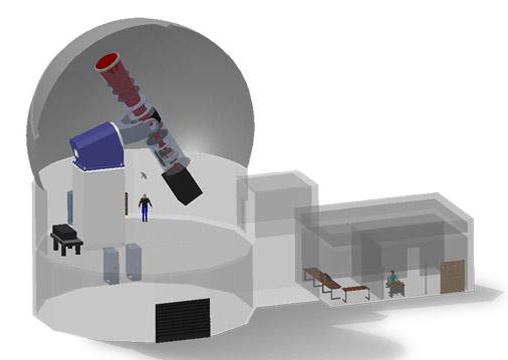NSF approves funding for next stage of NCAR’s new solar observatory
Funding will go toward surveying sites and completing telescope design
Dec 3, 2020 - by Staff
Dec 3, 2020 - by Staff
The National Center for Atmospheric Research (NCAR) has received funding approval to survey prospective locations for the Coronal Solar Magnetism Observatory (COSMO). This new observatory offers the potential to transform our fundamental understanding of magnetic fields in the Sun’s atmosphere and how they drive the formation of solar eruptions and other space weather that can affect technologies on Earth.

The National Science Foundation (NSF) has approved $5.6 million in funding for the next stage of the project, which will include searching for a suitable location for the observatory. Ground-based solar telescopes are best placed in areas with stable, largely clear weather — they can’t see through cloud cover — and high elevation, which raises the telescope above the distortions that can be caused by the thicker atmosphere closer to sea level.
The funding will also go to completing the design of the 1.5-meter Large Coronagraph telescope, which will provide a rare, large-scale view of magnetism in the solar corona, the tenuous extended atmosphere of the sun. This will allow scientists to quantify the energy stored in the looping magnetic fields that emanate from the Sun and to study how these fields may change before a solar eruption.
These observations will complement those taken from existing ground- and space-based solar observatories, including NSF’s new Inouye Solar Telescope, which sacrifices its wide view of the Sun in favor of unprecedented high resolution of a much smaller area.
“COSMO will provide the big picture on coronal magnetism,” said NCAR scientist Steve Tomczyk, who is leading the project. “The ability to track changes in the magnetic field across the layers of the Sun’s atmosphere on global scales will be a powerful tool for identifying and characterizing the sources of potentially damaging space weather and, ultimately, will provide better, more accurate, and more timely forecasts of the risk here on Earth.”
The COSMO Site and Design Advancement (COSADA) is being undertaken by a team of NCAR scientists and engineers, including Tomczyk, Sarah Gibson, Krista Laursen, and Scott Sewell, and will be conducted across three years. NCAR developed COSMO in partnership with the University of Michigan, the University of Hawaii, George Mason University, the Smithsonian Astrophysical Observatory, the University of Colorado, and the National Solar Observatory, along with other support in the solar community.
The project was also endorsed as a high priority in the latest Solar & Space Physics Decadal Survey of The National Academies of Sciences, Engineering, and Medicine.
Tiny electrically charged particles hurled toward Earth from a solar storm can disrupt radio communications, GPS signals, and other technologies that people rely on each day. Understanding solar storms and space weather will help society protect electric grids that power communities in an increasingly telecommunication-reliant world.
Scientists know that the Sun’s magnetism is the driving force behind these space weather events, but existing observations of the Sun give them a limited view of how magnetic fields evolve and change in the run-up to a violent eruption or other solar disturbance. Most magnetic observations of the Sun are of the photosphere, which is the Sun’s visible surface. But how the magnetic fields behave in the corona — the thin solar atmosphere that sits above the photosphere — may be more important to understanding the origins of space weather.
Global observations of the corona’s three-dimensional magnetic field are not possible with current telescopes, leaving a critical hole in our scientific knowledge. COSMO, more than a decade in development, would fill that hole.
Along with the Large Coronagraph, COSMO includes two other instruments. The white light K-coronagraph (K-Cor) has already been constructed and is currently deployed at NCAR’s Mauna Loa Solar Observatory, and the Chromosphere and Prominence Magnetometer (ChroMag) is due for deployment and testing in 2021. The suite of three instruments will work together to give a full picture of magnetic fields in the corona.
“Our star is the primary driver of the Earth system, and what happens on the Sun affects us here on this planet in myriad ways,” said Holly Gilbert, who leads NCAR’s High Altitude Observatory. “It could not be more important that we invest in the instruments we need to have a fuller understanding of the Sun and its variability. We are thrilled that the NSF recognizes the value of COSMO and is funding this next critical phase of this project.”
With its potential for improving the predictability of solar storms, COSMO is also a priority in the new NCAR Strategic Plan, which emphasizes the importance of undertaking actionable Earth system science for the benefit of society.